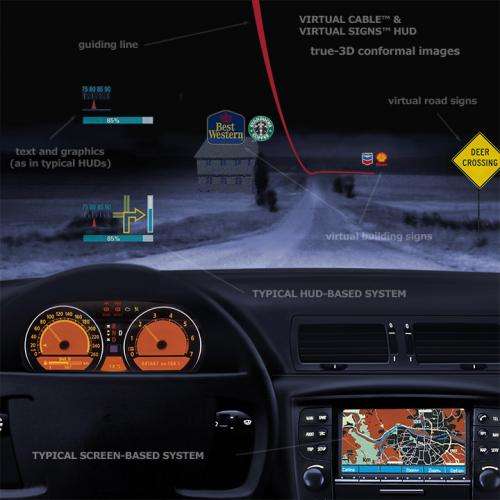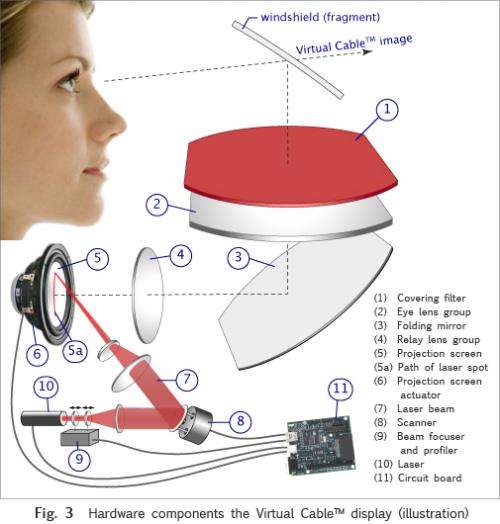October 27, 2011 report
Head-up display wins top navigation prize in Munich

(PhysOrg.com) -- A navigation system making use of something called "True3D" technology has won the top prize in this year's European Satellite Navigation Competition in Munich, Germany. The ESNC is an international innovation contest that awards the best ideas for applications in satellite navigation. There were 401 proposals from almost 50 countries. The winner was selected by an international panel of experts. The company that designed the system, Making Virtual Solid (MVS-California), entered its True3D Head Up Display & Navigation System, which won the Galileo Master 2011 grand prize of 20,000 Euros.
The HUD system is described as an augmented reality navigational display engine designed to provide non-distracting, translucent location guidance. Images are projected directly onto the car’s windshield.
“Non-distracting” and “translucent” are the strong attributes, as the company touts its system’s use of 3-D technology to beam the display across the entire front window of the car. With a less robust readout, that would be no better than a road map over glass, but “True3D” creates a readout that blends into what the driver sees on the road in front of the vehicle.
A luminous, three-dimensional landscape over the real world delivers information that the driver needs without the driver having to look elsewhere than on the road, and it is less distracting too than a small rectangle nearby the windscreen wipers.
The display carries virtual road signs to warn of conditions ahead. Attractions such as service stations and hotels are identified by virtual signs floating above them.
The images appear to be outside the windshield from a distance of two meters to infinity. They are described as volumetric (“truly 3-D”) and they are capable of refreshing at a rate of 60 frames per second.
The designers had pilot-level situational awareness in mind when working on the display design A no-need-to-think-about-it, realtime stream of information was the goal, yet it had to be cost-engineered for the car market, where drivers could see moving, not fixed, images, constantly refreshing. The system would have to be small, light and inexpensive enough to make its way into all cars.

“The world's foremost automotive display researchers had essentially given up trying to push the size and cost of 3-D conformal HUDs down far enough to enter the automotive supply chain. We did not,” says a company spokesman.
According to Making Virtual Solid, the technology requires a small hardware package, and can operate in bright sunlight,
According to Inside GNSS, MVS-California has designs and manufacturing plans and is seeking ecosystem partners to build on its system’s potential use in automotive, trucking, marine, and avionics markets.
More information:
galileo-masters.eu/index.php?k … anzeige=press47.html
www.mvs.net/technology.html#true3d
© 2011 PhysOrg.com


















